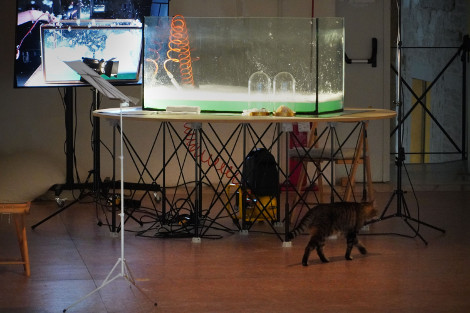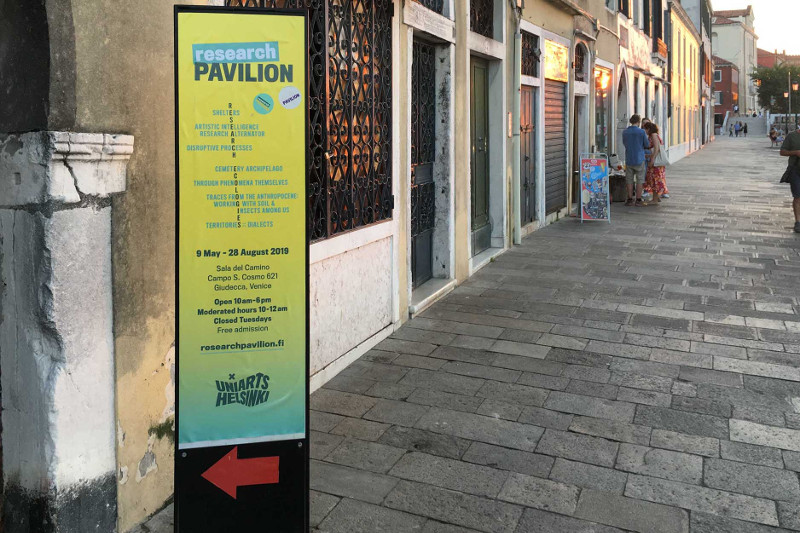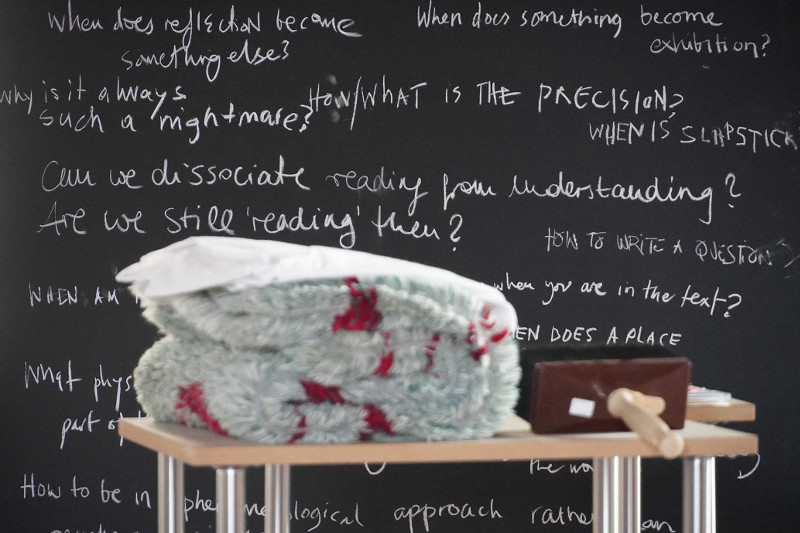Inbjudan
Arkiv

NR 14
Ecologies of Practice

After the Research Pavilion #3
This issue of RUUKKU has its starting point in the Research Pavilion #3 project that brought together more than fifty artist-researchers from twenty countries over a period of twenty months. The project started with an open call for "Research Cells" in April 2018 and evolved through a series of Research Cell Assemblies organised in Helsinki to an intensive period of activity in the context of the Venice Biennale. In Venice the home base of the project was Sala del Camino, the dormitory of a former monastery situated on Giudecca at a negotiable mental distance from the main venues of the Biennale. The venue functioned as a hybrid space for exhibiting, gathering, performing and practising over a period of four months (May-August 2019). The project was wrapped up in October 2019 in the form of a concise research exhibition event entitled RP#3 Info Lab that took place at the Exhibition Laboratory in Helsinki. The entire RP#3 project is extensively documented in the Research Catalogue:
https://www.researchcatalogue.net/view/474888/474889
https://www.researchcatalogue.net/view/474888/474889
The key aim of RP#3 was to foster new artistic research culture and collegial exchange. RP#3 was conceived as a meeting place, a catalyst of emerging co-operations in the area of artistic research and a generator of new thinking: a battery of research cells capable of recharging artistic research with new energy. The convenors of the project (Mika Elo and Henk Slager) together with a group of advisors (Esa Kirkkopelto, Giaco Schiesser, Anna-Kaisa Rastenberger and Ellen Røed) set the focus on facilitating artistic research processes in the frame of a series of assemblies and workshops. The issue of 'research ecologies' highlighted thematically in the public communications of the project emerged from those activities and encounters during the process.

The call for this RUUKKU issue re-framed this emergent topic and opened the doors for further research projects beyond the Research Cells involved in the Research Pavilion project. The call highlighted the ethico-political aspects of artistic research practice:
What can artistic research do in our current decade, where we suffer from a loss of common orientation, a common world, a common planet? How to develop sustainable modes of artistic research in and through processes of exhibiting, performing, exposing, collaborating, curating and discussing? How to articulate these research processes with related forms of critical reflection? How to deal with the individualistic tendencies in artistic research?
Nowadays, artistic research is challenged to articulate its idiosyncratic modes of thought even more forcefully and to address the present global environmental crisis while taking historical responsibilities into account and creating sustainable interconnections between research practices and their environments—in short: to articulate research ecologies.

The issue consists of fifteen expositions, eight of them deriving from the Research Pavilion #3 project. Some of them are linked with self-published project presentations made in the Research Catalogue. Alex Arteaga, Emma Cocker et al., Riikka Latva-Somppi et al., Maiju Loukola and Tuula Närhinen have used their project presentations developed and published in the frame of the Research Pavilion #3 as the key reference material for their expositions. This strategy foregrounds the fact that the gesture of exposing practice as research necessarily implies selecting, filtering, and focusing. To expose is to highlight something, and, by implication, to leave something else in a relative shadow.
In many of these expositions, the thoughtful use of various media suggests broader connections and contexts. The rich texture of sites, environments and nature becomes evident in both image and sound. This can point inwards, revealing something about the aesthetic sense and the world-view of the authors, but also outwards, hinting at a wider mesh of ecology. Furthermore, Research Pavilion #3 encouraged the artists and artist groups to create a long-term documentation and archival of the work material on the Research Catalogue. This shows the potential of RC as a live environment where research materials can be gestated.
We hope that this broad selection of expositions shows the richness and diversity of practices and environments artistic researchers are engaged with today.
Methods and Processes
Alex Arteaga's exposition "Aesthetic Practices of Very Slow Observation as Phenomenological Practices: Steps to an Ecology of Cognitive Practices" raises the question of aesthetic research in its relation to phenomenology. Arteaga's ecology of cognitive practices builds on methods developed, discussed and documented in the frame of RP#3. The exposition undertakes a processual definition of the aesthetic as a form of cognition in the framework of the embodied and situated cognition theory.
In their collaborative exposition "Reading on Reading: Ecologies of Reading", Emma Cocker, Cordula Daus and Lena Séraphin focus on the multi-faceted issue of reading as aesthetic practice. They approach reading as a reflexive and processual activity, a becoming. Through a rich presentation of various reading practices and experiments conducted in the frame of RP#3, the exposition invites the reader to reflect on different dimensions of the event of reading. Cocker, Daus and Séraphin also raise critical questions concerning collaboration in artistic research. They ask whether and how it might be possible to shift the notion of what artistic research does away from the preoccupation with knowledge production and goal-oriented work. How could we more attentively consider the different ecologies of shared practice in artistic research?
Charulatha Mani's exposition "The Eco-Mesh Approach: A Sustainable Methodology for Socio-Culturally Interrogative Artistic Research" aims to initiate an understanding of artistic research based on the ontologies and epistemologies of the Global South. Such a proposition requires a methodological approach with a profound level of awareness, involvement, and accountability, not only in the stratum of making, but especially in being outward-facing and impactful. Mani suggests a methodology that looks from the enmeshed and messy microcosms of ecologies in interplay to the broader macrocosmos of the world, and that could eventually articulate an ethical model for a decolonized artistic research ethos.
Encountering Environments
In "Behind the Back of Linnaeus" Annette Arlander relates her experiences from the project "Performing with Plants", with video works resulting from visits to a sycamore in Humlegården and a beech in Djurgården, Stockholm. In the exposition the artistic practice and the case are discussed through Isabelle Stengers' ecology of practices, debating the tension between the particularity of artistic research and the requirement of generality often present in environmental-ecological thought. Arlander's ecology of practice stems from the unique artistic encounters with the specific trees, building a legacy and genealogy of these encounters rather than with a taxonomy of plants, thus working "behind the back" of Linnaeus.
Mari Martin's exposition "Sensory Excursion as a Site of Encounter" relates her research as a member of a group called Ajauksia. The group worked with "sensory excursion", a frame and a set of exercises for encountering a site, involving both participation with humans and non-humans through processes of collaborating, performing and discussing. The different environments of the Kontula suburb of Helsinki and the island of Giudecca, Venice, the site of Research Pavilion #3, provide counterpoints for discussing the role of artists in the ecology of a site.
Tine Blom's exposition "Embodiment, Technology and Ecological Awareness at the Site of Deep Ecology" highlights the experiential qualities of environmental exploration through artistic means. She presents a case study of Tvergasteinstjørnet at Hallingskarvet Mountain building her observations on various field recordings and walks. In a dialogue with process ontological thinking and Deep Ecology, she delves into the embodied experience of landscape.
Material Practices
Maiju Loukola's The Foaming Exercises installation was part of one of the research cells of Research Pavilion #3. The exposition titled "From Foaming Exercises to Scenarios of Co-Existencies, Anticipating Emancipatory Spatial Practices" presents beginnings of an examination of spatial co-existencies, examining the properties of foam through a series of exercises. Reminiscent of microbiological environments and ecologies of material constraints, Loukola's work asks if the characteristics of foam can provide a framework for art and activity. Instead of taking these material qualities at face value, Loukola instead employs art as imaginary practice and attempts boldly to thematise foam's spatiality, metaphoric and conceptual implications.
Otso Lähdeoja's "Matter Dialogues" relates Claude-Lévi Strauss' concept of bricolage with two examples of the author's artistic practice, a sound art installation and a composition for double bass, video and electronics. The intent is to shed light on artistic work as a dialogical, enactive process where the dialogue with the artistic material – a complex interplay of environment, presences and concepts – takes a guiding role. For Lähdeoja, bricolage is not simply a lens for reflecting on the affordances of artistic processes. The concept has strong implications for seeing ourselves immersed in a nuanced, multi-modal world we need to be attuned to, a suitable way in into ecological thought and discourse.
Riikka Latva-Somppi, Maarit Mäkelä and Ozgu Gundeslioglu have co-authored the exposition "Traces from the Anthropocene: Working with Soil". Working with Soil was presented as an ongoing research project taking place before and during the high season of Research Pavilion #3. As a craftsperson appreciates and is attentive to the material, there is an element of "care thinking" in the practice of a craft. Here, the ceramists' care and sensitivity for clay becomes a means of examining various concerns relating to soil, including the science and politics of the environment. This attentiveness goes beyond the immediate material context, involving the communication with officials and sample analysis in a laboratory.
Non-Human Agency
In her exposition "Epistemic Bugs at Worldmaking", Tuula Närhinen presents a broad range of artistic research practices and sets them in a dialogue with entomology and phenomenotechnics. The key reference material of the exposition consists of the rich media documentation of the series of installations Närhinen realised in the Research Pavilion in Venice. Using the notion of "ecotone" she discusses the ecology of artistic research. Deriving from biology, the term refers to the tensional boundaries of adjacent habitats. Transposing the idea of productive tension to interdisciplinary research settings, Närhinen sees in the transitional dynamics of ecotone a fertile ground for interconnecting practices and generating diversity that might contribute to a (self)critical disciplinary rethinking of artistic research.
Esa Kirkkopelto's "Tick Variations" has its origins in Research Pavilion #3. The study consists of a case of non-human phenomenology, starting from Jakob von Uexküll statements on the tick's supposedly limited life-world. Kirkkopelto contests this through his artistic practice, involving the bodily techniques developed with the Other Spaces group, enabling "modes of being parallel to the human experience". The study outcomes suggest that it is meaningful to create virtual corporeal interfaces between human and non-human species, as the capability for corporeal imagination can be found in both humans and non-humans.
Laura Bissell discusses artistic encounters with beavers in the exposition "Landscaping with Beavers" as a participant in a group of artists who sought multi-species collaboration and "making kin" with beavers in the area of Pertshire, Scotland. The elusive yet present animal provides the focus for the various performative art and research activities, such as mimetic behaviour. Bissell provides a snapshot of the few days in which these diverse activities took place, locating herself as a narrator of events and supplying artistic reflection on the activities.
Rethinking Impact
In their report "Situating Practices: An Ecological Approach to Exhibition Making", Claire Robyn Booth-Kurpnieks and Louise Atkinson explore, based on a critical evaluation of the 2019 eponymous exhibition at the Market Gallery in Huddersfield, what it means to do research in, with, and through practice. But also what does it actually mean when "objects of thinking" are put together? In other words: what role does public display play in "curating research"? To answer these questions, the authors deploy the perspective developed by Fritjof Capra in "Principles of Ecology" (1996): a curatorial ecosystem must have "networks", "nested systems", "interdependent relations", "diversity", "cycles", "flows of energy", "development", and a "dynamic balance".
The exposition "Artistic Research on Dialogical Aesthetics – Ethics of Gathering" by Katja Juhola, Maria Huhmarniemi, and Kaisa Raatikainen, evaluates the 2019 edition of the ISEAS symposium. This annual symposium – The International Socially Engaged Art Symposium – takes place in Western Lapland. From a more locally oriented perspective, it explores various aspects of research ecologies: strategies of dialogical art, articulating communities' worldviews, coping with local natural conditions, and living in an equal relationship with non-human nature. Starting from an evaluation of this symposium, the authors attempt to outline the contours of a new-materialist research ethics: how to develop a low ecological footprint (human impact on the planet) while examining an ecological handprint which presents contributions towards a sustainable future?
Pekka Kantonen's exposition is called "Taiteellinen näkökulma taiteen vaikuttavuuden tutkimiseen: Tapaustutkimus Baltic Circlen Vaikuttamisen festivaali" (Aa artistic viewpoint on researching the impact of art: A case study of the Baltic Circle Impact Festival). Kantonen applies his generational filming method to examine the festival. As the interviewed again view their past interview on video, another generation of interviews is produced. Kantonen asks if the method works for studying the impact of art through artistic means.

